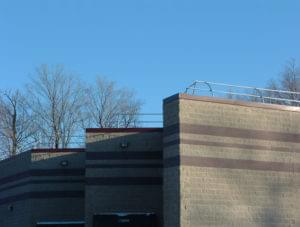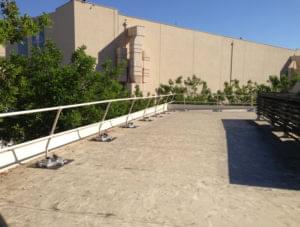An attractive campus starts with beautiful buildings. Even a cursory glance at Architectural Digest’s 50 Most Beautiful Colleges in America makes it abundantly clear: campus architecture—whether classic or contemporary—plays a large part in school perception and culture. It’s no wonder universities and other institutions of higher education spend so much time and money maintaining and restoring their original buildings. Careful consideration is given to new construction and how it fits in, both with the landscape and the existing structures. Planners and designers want to create a unified appearance on campus, an admirable challenge on campuses that likely includes buildings erected over the course of several decades or centuries! Because of this, safety railings and rooftop fall protections might be the furthest thing from their minds.
The fact is, all commercial buildings are required to have fall protection equipment on their rooftops, and that includes educational facilities—no matter what the design aesthetic. Whether it's a brand new steel and glass student center or a century-old gothic library, roof fall protection systems are non-negotiable.
Designers, however, may cringe at the standard yellow safety railings. Indeed, they can be an eyesore on an otherwise thoughtfully-designed structure. Bright yellow also might not be ideal anywhere but a university athletic center—and that’s usually only if the school colors happen to include it. Fortunately, you can meet OSHA regulations without detracting from the color scheme or aesthetic appeal of the campus with custom-painted safety railings and/or and architectural guard rail system.

The roof of a typical college campus building is most likely empty most of the time. Even still, a guard rail system is required. At some point, a worker will need to be on the roof to check for damages, fix the HVAC system, clear debris, or install something new. No matter the job, campus employees and contract workers alike must be provided with the proper safety equipment for the work they do on top of the building. While third-party companies might have their own fall protection, building owners are still responsible for taking measures to protect against falls—particularly considering that service employees may not be the only ones who access the roof.
A university building roof may serve as an educational space to conduct experiments, study solar energy or astrophysics, grow a garden, and so on. All students have the right to feel safe and secure in any learning environment they find themselves in.
Then there is the unfortunate fact that students and other individuals may access the roof without guidance or permission—this is particularly true of dormitory roofs. It may be against campus rules, but any planning committee would be remiss in not taking this into consideration. Regardless of who, why, and how someone got on the roof, no college or university wants to put their student body’s safety (or their reputation) on the line.
Most people think that roof edges are the most dangerous part of the roof, and with good reason. But skylights, access points, and other roof holes can be equally precarious. Despite these obvious dangers, fall protection was the most-cited OSHA safety violation in 2018. Given the thorough guidelines provided by OSHA, there's no excuse for such a large number of violations if employers are truly putting the safety first.
According to OSHA regulations, "Each employee on a walking/working surface (horizontal and vertical surface) with an unprotected side or edge which is 6 feet (1.8 m) or more above a lower level shall be protected from falling by the use of guardrail systems, safety net systems, or personal fall arrest systems."

In addition: "Each employee on walking/working surfaces shall be protected from falling through holes (including skylights) more than 6 feet (1.8 m) above lower levels, by personal fall arrest systems, covers, or guardrail systems erected around such holes."
A guard rail system is a great start for campus buildings, specifically because of the different reasons people may find themselves on the roof. But if there is specific work being done, employees may need other roof fall protection systems in addition to a guard rail system. A personal fall arrest system, like a harness and lanyard, or a safety net may be required. Guard rails should also be installed around any rooftop equipment, like HVAC systems or solar panels, to discourage access by unauthorized personnel. Safety gates can easily be added to those systems so the equipment can be accessed by professionals as needed. Ladders and access stairs can be guarded with specific gates designed to keep unauthorized persons off the roof and out of harm’s way.
For a more thorough review, we recommend reading OSHA’s Protecting Roofing Workers. This is an easy-to-read reference for general roof safety guidelines with links to specific standards that further define each safety topic in detail.
Unifying your campus design may mean looking for options beyond the standard yellow safety railings. The good news is, if you choose the right manufacturer, custom colors are available. Whether you choose to complement the color of the building, represent your university team color, or go with a neutral galvanized steel, the right safety rail system can enhance or even disappear from your aesthetic design. At BlueWater, we take it a step further and offer an Architectural Series—a thoughtfully-designed guard rail system with pleasing sightlines that maintain OSHA-compliant safety standards.

Another consideration is your rooftop itself. A non-penetrating design can offer the same protection from fall hazards without compromising the membrane of the roof, so long as it meets OSHA’s criteria. This may prove especially helpful to older buildings and those with historic significance.
Properly installed OSHA-compliant fall protection is essential, but it doesn't have to be an eyesore. When done correctly, it can work with, not against, the visual appeal of your buildings. Partnering with the right safety manufacturer is a big part of achieving that goal. At BlueWater, we make it our business to know rooftop safety inside and out. We're happy to partner with you to discuss customization options that can maintain both your aesthetic and provide the utmost in rooftop fall protection. If you need to add safety to your campus and don’t want to compromise your architectural beauty, give us a call today.